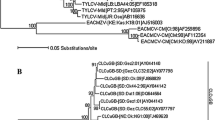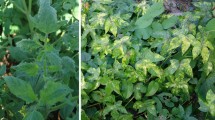Abstract
Tomato yellow leaf curl (TYLC) and tomato leaf curl (ToLC) diseases are serious constraints to tomato production in Mali and other countries in West Africa. In 2003 and 2004, samples of tomato showing virus-like symptoms were collected during a survey of tomato virus diseases in Mali. Three predominant symptom phenotypes were observed: (1) TYLC/ToLC (stunted upright growth and upcurled leaves with interveinal yellowing and vein purpling), (2) yellow leaf crumple and (3) broccoli or bonsai (severe stunting and distorted growth). Squash blot (SB) hybridization with a general begomovirus probe and/or SB/PCR analyses revealed begomovirus infection in plants with each of these symptom phenotypes and no evidence of phytoplasma infection. Sequence analysis of PCR-amplified begomovirus fragments revealed two putative new begomovirus species associated with the TYLC/ToLC and yellow leaf crumple symptom phenotypes, respectively. Full-length clones of these begomoviruses were obtained using PCR and overlapping primers. When introduced into N. benthamiana and tomato plants, these clones induced upward leaf curling and crumpling (the TYLC/ToLC-associated begomovirus) or downward leaf curl/yellow mottle (yellow leaf crumple-associated begomovirus) symptoms. Thus, these begomoviruses were named tomato leaf curl Mali virus (ToLCMLV) and tomato yellow leaf crumple virus (ToYLCrV). The genome organization of both viruses was similar to those of other monopartite begomoviruses. ToLCMLV and ToYLCrV were most closely related to each other and to tobacco leaf curl Zimbabwe virus (TbLCZV-[ZW]) and tomato curly stunt virus from South Africa (ToCSV-ZA). Thus, these likely represent tomato-infecting begomoviruses that evolved from indigenous begomoviruses on the African continent. Mixed infections of ToLCMLV and ToYLCrV in N. benthamiana and tomato plants resulted in more severe symptoms than in plants infected with either virus alone, suggesting a synergistic interaction. Agroinoculation experiments indicated that both viruses induced symptomatic infections in tomato and tobacco, whereas neither virus induced disease symptoms in pepper, common bean, small sugar pumpkin, African eggplant, or Arabidopsis. Virus-specific PCR primers were developed for detection of ToLCMLV and ToYLCrV and will be used to further investigate the distribution and host range of these viruses.



Similar content being viewed by others
References
Bedford ID, Kelly A, Banks GK, Briddon RW, Cenis JL, Markham PG (1999) Solanum nigrum: an indigenous weed reservoir for a tomato yellow leaf curl geminivirus in Southern Spain. Eur J Plant Pathol 104:221–222
Briddon RW, Mansoor S, Bedford ID, Pinner MS, Saunders K, Stanley J, Zafar Y, Malik KA, Markham PG (2001) Identification of DNA components required for induction of cotton leaf curl disease. Virology 285:234–243
Chen LF, Hagen C, Zhou Y, Noussourou M, Kon T, Rojas M, Gilbertson RL (2007) Emergence of tomato leaf curl and yellow leaf curl diseases in West Africa: identification of a novel begomovirus-satellite DNA complex. Phytopathology 97:S154
Cohen S, Kern J, Harpaz I, Ben-Joseph R (1988) Epidemiological studies of the tomato yellow leaf curl virus (TYLCV) in the Jordan Valley, Israel. Phytoparasitica 16:259–270
Czosnek H, Laterrot H (1997) A worldwide survey of tomato yellow leaf curl viruses. Arch Virol 142:1391–1406
Dellaporta SL, Wood J, Hicks JB (1983) A plant DNA minipreparation: version II. Plant Mol Biol Rep 1:19–21
Dry IB, Rigden JE, Krake LR, Mullineaux PM, Rezaian MA (1993) Nucleotide sequence and genome organization of tomato leaf curl geminivirus. J Gen Virol 74:147–151
Faria JC, Maxwell DP (1999) Variability in geminivirus isolates associated with Phaseolus spp. in Brazil. Phytopathology 84:321–329
Fauquet C, Stanley J (2003) Geminivirus classification and nomenclature: progress and problems. Ann Appl Biol 142:165–189
Gilbertson RL, Faria JC, Hanson SF, Morales F, Ahlquist P, Maxwell DP, Russell DR (1991) Cloning of the complete DNA genomes of four bean-infecting geminiviruses and determining their infectivity by electric discharge particle acceleration. Phytopathology 81:980–985
Gilbertson RL, Hidayat SH, Paplomatas EJ, Rojas MR, Hou YM, Maxwell DP (1993) Pseudorecombination between infectious cloned DNA components of tomato mottle and bean dwarf mosaic geminiviruses. J Gen Virol 74:23–31
Hanley-Bowdoin L, Settlage SB, Orozco BM, Nagar S, Robertson D (1999) Geminiviruses: models for plant DNA replication, transcription, and cell cycle regulation. Crit Rev Plant Sci 18:71–106
Hong YG, Harrison BD (1995) Nucleotide sequences from tomato leaf curl viruses from different countries: evidence for three geographically separate branches in evolution of the coat protein of whitefly transmitted geminiviruses. J Gen Virol 76:2043–2049
Hou YM, Paplomatas EJ, Gilbertson RL (1998) Host adaptation and replication properties of two bipartite geminiviruses and their pseudorecombinants. Mol Plant-Microbe Interact 11:208–217
Kon T, Hidayat SH, Hase S, Takahashi H, Ikegami M (2006) The natural occurrence of two distinct begomoviruses associated with DNAβ and a recombinant DNA in a tomato plant from Indonesia. Phytopathology 96:517–525
Konate G, Fargette D, Swanson MM, Harrison BD (1995) Occurrence of whitefly-transmitted geminiviruses in crops in Burkina Faso, and their serological detection and differentiation. Ann Appl Biol 126:121–129
Kumar S, Tamura K, Nei M (2004) MEGA3: Integrated software for molecular evolutionary genetics analysis and sequence alignment. Brief Bioinform 5:150–163
Legg JP, Fauquet CM (2004) Cassava mosaic geminiviruses in Africa. Plant Mol Biol 56:585–599
Mansoor S, Briddon RW, Zafar Y, Stanley J (2003) Geminivirus disease complexes: an emerging threat. Trends Plant Sci 8:128–134
Nakhla MK, Maxwell DP, Carvalho MG, Gilbertson RL (1994) Widespread occurrence of the eastern Mediterranean strain of tomato yellow leaf curl geminivirus in tomatoes in the Dominican Republic. Plant Dis 78:926
Navot N, Picherski E, Zeidan M, Zamir D, Czosnek H (1991) Tomato yellow leaf curl virus: a whitefly-transmitted geminivirus with a single genomic molecule. Virology 185:151–161
Paplomatas EJ, Patel VP, Hou YM, Noueiry AO, Gilbertson RL (1994) Molecular characterization of a new sap-transmissible bipartite genome geminivirus infecting tomatoes in Mexico. Phytopathology 84:1215–1224
Patel VP, Rojas MR, Paplomatas EJ, Gilbertson RL (1993) Cloning biologically active geminivirus DNA using PCR and overlapping primers. Nucleic Acids Res 21:1325–1326
Polston JE, Anderson P (1997) The emergence of whitefly-transmitted geminiviruses in tomato in the Western Hemisphere. Plant Dis 81:1358–1369
Polston J, McGovern RJ, Brown LG (1999) Introduction of tomato yellow leaf curl virus in Florida and implications for the spread of this and other geminiviruses of tomato. Plant Dis 83:984–988
Rasheed MS, Selth LA, Koltunow AM, Randles JW, Rezaian MA (2006) Single-stranded DNA of Tomato leaf curl virus accumulates in the cytoplasm of phloem cells. Virology 348:120–132
Rojas MR, Gilbertson RL, Russell DR, Maxwell DP (1993) Use of degenerate primers in the polymerase chain reaction to detect whitefly-transmitted geminiviruses. Plant Dis 77:340–347
Rojas MR, Hagen C, Lucas WJ, Gilbertson RL (2005) Exploiting chinks in the plant’s armor: evolution and emergence of geminiviruses. Annu Rev Phytopathol 43:361–394
Rojas MR, Jiang H, Salati R, Xoconostle-Cazares B, Sudarshana M R, Lucas WJ, Gilbertson RL (2001) Functional analysis of proteins involved in movement of the monopartite begomovirus, Tomato yellow leaf curl virus. Virology 291:110–125
Salati R, Nahkla MK, Rojas MR, Guzman P, Jaquez J, Maxwell DP, Gilbertson RL (2002) Tomato yellow leaf curl virus in the Dominican Republic: Characterization of an infectious clone, virus monitoring in whiteflies, and identification of reservoir hosts. Phytopathology 92:487–496
Saunders K, Norman A, Gucciardo S, Stanley J (2004) The DNA beta satellite component associated with ageratum yellow vein disease encodes an essential pathogenicity protein (betaC1). Virology 324:37–47
Seo Y-S, Zhou Y-C, Turini TA, Cook CG, Gilbertson RL, Natwick ET (2006) Evaluation of cotton germ plasm for resistance to the whitefly and cotton leaf crumple (CLCr) disease and etiology of CLCr in California’s Imperial Valley. Plant Dis 90:877–884
Smart CD, Schneider B, Blomquist CL, Guerra LJ, Harrison NA, Ahrens U, Lorenz KH, Seemuller E, Kirkpatrick BC (1996) Phytoplasma-specific primers based on sequences of the 16S–23S rRNA spacer region. Appl Environ Microbiol 62:2988–2993
Varma A, Malathi VG (2003) Emerging geminivirus problems: a serious threat to crop production. Ann Appl Biol 142:145–164
Wyatt SD, Brown JK (1996) Detection of subgroup III geminivirus isolates in leaf extracts by degenerate primers and polymerase chain reaction. Phytopathology 86:1288–1293
Zhou X, Xie Y, Tao X, Zhang Z, Li Z, Fauquet CM (2003) Characterization of DNAβ associated with begomoviruses in China and evidence for co-evolution with their cognate viral DNA-A. J Gen Virol 84:237–247
Acknowledgments
This research was funded by grants from the United States Agency for International Development as part of the IPM-CRSP and ABSP II.
Author information
Authors and Affiliations
Corresponding author
Rights and permissions
About this article
Cite this article
Zhou, YC., Noussourou, M., Kon, T. et al. Evidence of local evolution of tomato-infecting begomovirus species in West Africa: characterization of tomato leaf curl Mali virus and tomato yellow leaf crumple virus from Mali. Arch Virol 153, 693–706 (2008). https://doi.org/10.1007/s00705-008-0042-9
Received:
Accepted:
Published:
Issue Date:
DOI: https://doi.org/10.1007/s00705-008-0042-9




